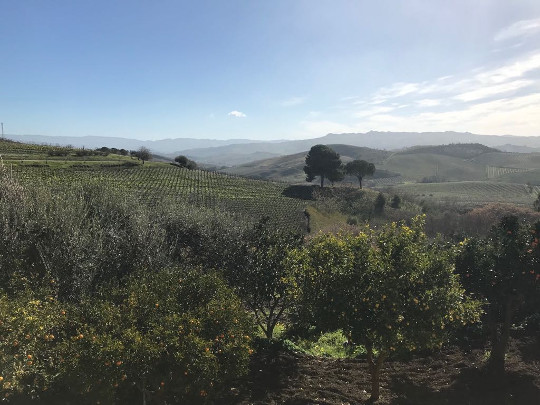Fabrizia often asks us about the connection between landscape and cuisine. How does what we see out of our windows affect what ends up on our plates? I’ve been thinking about that question in terms of planting and consuming, and both perspectives clash with our drive and desire for efficiency.
From a horticultural perspective, how we grow plants affects our landscapes. Every morning we walk by olive trees, gristly trunks and smooth leaves. These trees are the backdrop for the Mediterranean, shrugging their craggy arms up and down Italy. These trees are incredible, they grow on the side of hills, sporadic and secure, in poky places. But they have also been reinvented for modern agriculture; modern varietals are short, annually-producing trees, planted in tidy rows, easy to prune, cultivate, and harvest.
There is nothing wrong with neat rows of trees, but they are undoubtedly changing the landscape, drastically reducing the number of varieties planted. And of course, as more flat agricultural production happens in Morocco or Spain, the maintenance and cultivation of older trees, from scrambling up into hills or in some cases, harvesting by hand, becomes less viable for farmers in other parts of the Mediterranean. Olive trees still mark the Italian landscape, but increasingly, they are haunting specters, abandoned, wild, and left to their own devices.
This isn’t a rant against modern agriculture. It is a tallying up of cost, trying to understand what we trade when we focus primarily on decreased labor costs and increased production.
The second connection between place and plate is seasonality. A wonderful Anna Tasca Lanza program alumni and chef told me about a visit to the market in Palermo last week. A Sicilian friend kept warning her away from the produce: “Look at those strawberries — but don’t buy them, they’re not in season. Oh, the eggplant — but don’t get them, they’re not in season either. And the peppers! But of course they’re not in season.”
There is something incredibly humbling about reducing eating expectations to what is available around us. Especially in Valledolmo, where the butcher (when he’s open) replies to most inquiries with “Domani! Tomorrow! We’ll have it tomorrow!” There aren’t unlimited chicken thighs in the village. Sometimes the fresh grocer is out of cauliflower (even when it’s in season!). The best we can do is look for the truck parked in the square in the morning, for whatever veggies and fruit Piero brings, tweaking the menu to follow suit.
I don’t know what that means for our diet long-term, especially returning to Nebraska where no one can survive on soybeans, steak, and corn forever. And to some extent, a strictly seasonal diet is unreasonable and defies some of the best things about globalization. No one wants to return to days of scurvy.
But there is no doubt to me after living and eating here for three weeks, that eating seasonally connects us better to the land and puts produce on plate that tastes fresh and full of character, bumps and knobs, sunshine, and dirt.
So in lieu of a recipe, here is our food for thought: How does our landscape affect what we plant and eat? How are we connected (or disconnected) from the places outside our window? And what is the long-term cost of that kind of relationship?
Bon appetit and ciao, tutti!


